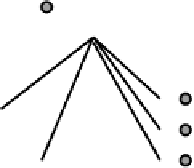Information Technology Reference
In-Depth Information
this time involving the
active memory
(maintenance) of
information instead of learning rate. As described ear-
lier, active memories can be supported by bidirectional
connectivity, and they are important for both memory
and influencing processing in other brain areas. How-
ever, a couple of specializations are necessary to sup-
port a robust form of active maintenance that can also
be rapidly updated (Cohen, Braver, & O'Reilly, 1996;
O'Reilly, Braver, & Cohen, 1999a).
For example, if active memories are used in con-
junction with highly overlapping distributed represen-
tations, information tends to spread to the overlapping
representations when it is supposed to be maintained.
Although this spreading activation can be useful for per-
forming
inference
(e.g., when you see smoke, spreading
activation can activate “fire”), it is not useful for accu-
rately maintaining information over time. Furthermore,
active maintenance needs to be considerably more ro-
bust than the more transient activation signals used in
performing sensory motor mappings, because the ef-
fects of noise and interference from other activity in the
network tend to accumulate over time.
As we will see in chapter 9, one way to produce
a more robust active maintenance system is to
isolate
the representations more. This prevents spread, but
also eliminates all of the potential benefits of spread-
ing activation. This tradeoff can be resolved by having
a specialized system for active maintenance, that uses
more isolated representations (i.e.., the frontal cortex),
in conjunction with a posterior cortical system that has
overlapping distributed representations and can there-
fore perform inference and generalization.
Another specialization that the active maintenance
system requires is a mechanism that allows for both
rapid updating when new information is to be main-
tained and robust maintenance in the face of noise and
activation elsewhere in the system. These are contra-
dictory, but both can be achieved by using a neuromod-
ulatory mechanism that dynamically regulates (“gates”)
the strengths of the inputs to the active maintenance sys-
tem (Cohen et al., 1996; Hochreiter & Schmidhuber,
1995). Because this specialization would presumably
be unnecessary for a nonactive maintenance system, it
provides further motivation for having a specialized ac-
tive maintenance system.
HC
PC
FC
Figure 7.7:
Diagram of key properties of the three prin-
cipal brain areas. Active representations are shown in
white; highly overlapping circles are distributed representa-
tions; non-overlapping are isolated; in between are separated.
Weights between active units are shown in solid lines; those
of nonactive units in dashed. Three active representations are
shown, which can be thought of as feature values along three
separate “dimensions” (e.g., modalities).
PC
posterior cortex
representations are distributed and embedded in specialized
(e.g., modality specific) processing areas.
FC
frontal cortex
representations are isolated from each other, and combinato-
rial, with separate active units representing each feature value.
Unlike other areas, frontal cortex units are capable of robust
self-maintenance, as indicated by the recurrent connections.
HC
hippocampal representations are sparse, separated (but
still distributed), and conjunctive, so that only a single repre-
sentation is active at a time, corresponding to the conjunction
of all active features.
7.5
Toward a Cognitive Architecture of the Brain
The central characteristics of the three different brain
systems described previously are illustrated in fig-
ure 7.7. The basic picture is that the posterior cortex
learns slowly to form integrative, distributed, overlap-
ping representations with dense interconnectivity. It can
exhibit short term active memory, but this is relatively
easily interrupted by new incoming stimuli. The frontal
cortex also learns slowly, but has more isolated rep-
resentations and dynamic regulation mechanisms that
enable it to maintain active memories over longer de-
lays and in the face of new incoming stimuli. Finally,














Search WWH ::

Custom Search